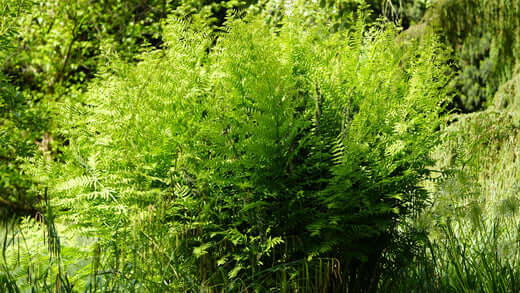The Royal Fern, Osmunda regalis, is a stunning and majestic addition to any garden. Known for its tall, graceful fronds and lush, vibrant green foliage, this hardy fern offers a touch of elegance to landscapes, especially in shaded or moist areas. It's beloved for its regal appearance and versatility, but like any plant, it requires understanding its needs and characteristics to thrive in the garden.
Does Royal Fern Like Sun or Shade?
The Royal Fern prefers dappled or partial shade, making it an excellent plant for wood gardens or areas that receive indirect light. It can tolerate some sun, especially in cooler climates or when planted near water, but it thrives best when protected from the intense rays of midday sunlight. Unaffected sunlight can cause the soft fronds to burn or dry out, particularly in hotter regions. A key to growing Royal Fern successfully is replicating its natural habitat - the cool, damp understory of forests.
In its native environment, the Royal Fern grows along streams, rivers, and wetlands, where it enjoys the natural shelter provided by taller trees and the constant moisture that comes from proximity to water. If you're planting Royal Fern in your garden, choosing a spot with filtered light or morning sun followed by afternoon shade will keep it healthy and looking its best. If full shade is your only option, Royal Fern can flourish, but its growth may be slower and its fronds less robust.
Is Royal Fern a Perennial or Annual?
The Royal Fern is a perennial plant, meaning it will return year after year, provided it's planted in a suitable location. One of the joys of growing this fern is its longevity. Over time, the Royal Fern can establish itself as a critical feature in your landscape, offering lush greenery season after season. Unlike annual plants that finish their life process in one growing season, the Royal Fern survives through winter, going dormant during colder seasons and re-emerging in spring.
During the growing season, the Royal Fern will reach impressive heights, with fronds growing up to six feet tall in optimal conditions. In the fall, its foliage takes on a beautiful bronze hue before dying back, contributing to the plant's ornamental value. Though it may disappear in the winter, it's reassuring to know that come spring, the fern will burst back into life, bringing renewed vitality to the garden.
What Is Royal Fern Used For?
The Royal Fern serves both aesthetic and practical purposes in the garden. It is primarily grown for its ornamental value, with its large, elegant fronds creating a soft, feathery texture that contrasts beautifully with other plants. Its honorable growth pattern and dense foliage make it a perfect backdrop for smaller perennials or a striking standalone specimen in shaded garden beds.
Beyond its beauty, Royal Fern is also excellent for naturalizing in wet, woodland areas. It is an ideal choice if you have a pond, stream, or low-lying area in your garden prone to standing water. Royal Fern can help stabilize soil in these moist environments, reducing erosion and contributing to the overall health of your garden ecosystem. Because of its moisture-loving nature, Royal Fern is often used in rain gardens, where it helps manage water runoff and supports local wildlife habitats.
In addition to its role in the garden, the Royal Fern has been historically valued for its medicinal properties. In traditional herbal medicine, the roots of the Royal Fern were used to treat ailments such as muscle cramps and arthritis. While it's not commonly used in modern herbal practices, this historical significance adds another layer of interest to the plant, especially for gardeners who appreciate the link between plants and their past uses.
Where to Plant Royal Fern?
Locating where to plant Royal Fern is critical to ensuring its success. As a moisture-loving plant, it's happiest in consistently damp soil so that the ideal spot would be near water features like ponds or streams. Alternatively, if your garden doesn't have natural water sources, planting Royal Fern in low-lying areas that tend to retain water after rainfall will give it the conditions it needs to thrive. However, while it loves moisture, it does not tolerate standing water for long periods, so ensuring adequate drainage is essential to control root rot.
The dirt should be fatty, loamy, and slightly acidic to tepid, mimicking the forest floors where this fern naturally grows. Adding organic matter such as compost or leaf decay can help improve soil quality and moisture retention. If you're planting in a garden bed, spacing is essential - Royal Fern can spread over time and will appreciate the room to grow without competing too heavily with neighboring plants.
Royal Fern also works well in shaded borders, where its tall fronds can create a soft, natural screen. It's particularly striking when paired with other shade-loving perennials like hostas, astilbes, or Japanese-painted ferns. Royal Fern's height and graceful form make it an excellent backdrop plant if you're planting in a mixed perennial bed. At the same time, its changing foliage colors throughout the seasons provide year-round interest.
In addition to garden beds, Royal Fern can also be grown in large containers, provided it's kept well-watered and in a shady location. This makes it a versatile plant for gardeners with smaller spaces or those who want to add a touch of woodland beauty to their patios or balconies.
With its graceful beauty, adaptability, and hardiness, Royal Fern is a beautiful addition to gardens that seek to recreate a woodland's serene, lush atmosphere. Whether you plant it by a water feature, in a shaded garden bed, or in a container, Royal Fern will reward you with its elegant fronds and soothing presence year after year.

